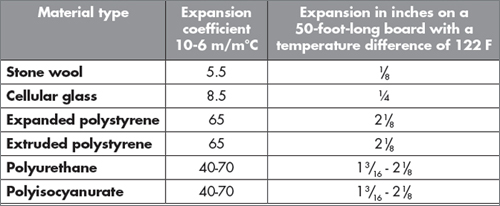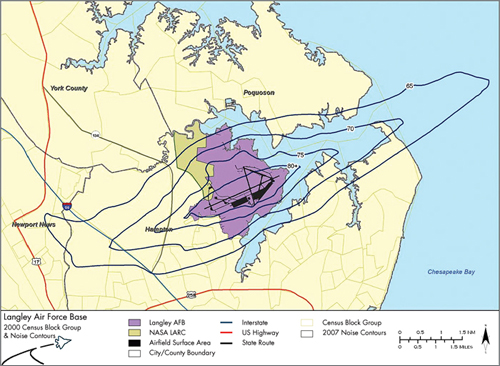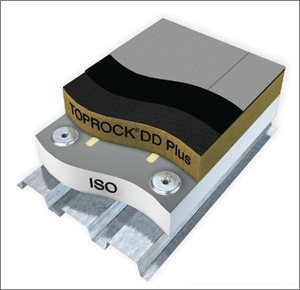Editor's note: The opinions in this article are those of the author's and not NRCA.
Stone wool insulation provides roof system designers with various design alternatives, allowing them to increase a roof system's overall performance. When used with foam plastic insulation, stone wool insulation can help maintain a roof system's thermal performance.
Hybrid materials
Roof system designers have an increasing number of choices when it comes to insulation, and every designer must rely on a number of criteria. According to The NRCA Roofing Manual: Membrane Roof Systems—2011: "An ideal roof insulation would have the following properties: compatibility with bitumen and other adhesives; component compatibility; impact resistance; fire resistance; moisture resistance; thermal resistance; stable R-value; attachment capability; dimensional stability; and compressive strength. … In reality, no single commercially available rigid board insulation product currently available has all these ideal properties. Therefore, designers need to choose rigid board insulation materials that have properties best suited to specific project conditions."
Foam roofing insulation, particularly polyisocyanurate, has a higher published R-value than other commercially available insulating products. For this reason, designers historically have selected foam as the insulation of choice. Stone wool insulation is made from basalt rock and steel slag, encompassing materials that naturally bestow fire, mold and mildew resistance, as well as dimensional stability.
Manufacturing processes enable these materials to be water-repellent, impact-resistant and sound-absorbent. Together, the inherent characteristics and production process deliver durable insulation with a stable R-value in the field.
Dimensional stability
To minimize stress movement between a roof membrane and adhesive substrate, insulation should be dimensionally stable at a range of temperatures.
Figure 1 highlights the coefficient of thermal expansion of some common roof insulation materials at 122 F. Note the significant differences between the various roof membrane substrates, translating into the degree of movement below the membrane and degree of gaps created between roof boards.

Figure 1: Coefficient of thermal expansion on roof insulation materials at 122 F
As a result, dimensionally stable products minimize heat loss through insulation gaps. According to the article "Effects of Mechanical Fasteners and Gaps between Insulation Boards on Thermal Performance of Low-Slope Roofs" in the Journal of Thermal Envelope and Building Science's April 2000 issue: "Relative to non-thermally bridged, polyisocyanurate foam insulation on a metal deck, gaps significantly reduced the roof R-value."
The article also documented 1-inch-wide gaps in a two-layer insulation configuration reduced a roof system's R-value 14.5 percent at a 30 F mean insulation temperature and 10.2 percent at a 123 F mean insulation temperature. For a one-layer configuration, the roof system's R-value was reduced 16.7 percent at a 30 F mean insulation temperature and 14 percent at a 123 F mean insulation temperature. This suggests using materials that are dimensionally stable not only minimizes friction between the membrane and the bonding adhesive but also enhances the benefits of installing continuous roof insulation in two layers as promulgated by good roofing practice.
Thermal performance
Different insulation types use different manufacturing methods to create R-values. Stone wool insulation only uses trapped air and is not affected by diffusion. Closed-cell foam plastics use blowing agents such as pentane to provide higher R-values. Foam plastics such as polyisocyanurate foam will experience decreased R-values over time as the gases exit the material as part of the aging process.
Stone wool insulation's thermal resistance is a function of entrapped air between the fibers. Therefore, the stated R-value will last the life of the design, provided all conditions monitored by ASTM C518, "Standard Test Method for Steady-State Thermal Transmission Properties by Means of the Heat Flow Meter Apparatus," remain the same. Without planning, a decrease in thermal resistance will result in an unexpected performance drop in thermal envelope and decreased energy efficiency.
The roofing industry uses a published R-value tested at a 75 F mean temperature. If the exterior temperature is 25 F, the R-value and U-value will be different—affecting the dew point and thermal-envelope resistance. Mechanical engineers typically use heating degree days and cooling degree days to determine their thermal requirements; however, one must consider the exterior temperature's starting point and how it affects the thermal performance if compared with the 75 F published R-value.
According to Information Sheet 502, "Understanding the Temperature Dependence of R-values for Polyisocyanurate Roof Insulation," published in 2013 by Building Science Corp., Somerville, Mass., a building science consulting and architecture firm, some foam plastic insulation experiences a reduction in R-values at lower temperatures. By incorporating an equal or thicker top layer of stone wool insulation, designers can keep the roof system's temperature closer to the designed thermal gradient. This means the temperature's rate of change from a location's interior to exterior will be more accurate and closer to the specification based on the insulation values published on technical data sheets.
Another factor complicating issues for designers is being able to determine K-values, or heat transfer, with respect to materials and their abilities to conduct heat given different climatic conditions.
Recent field-monitoring research conducted by RDH Engineering, Omaha, Neb., observed a thermal lag with-in stone wool insulation compared with polyisocyanurate insulation. According to RDH Engineering's research paper "Monitored Field Performance of Conventional Roofing Assemblies—Measuring the Benefits of Insulation Strategy" presented during RCI's 2013 Symposium on Building Envelope Technology: "This shows up in dampened heat flux measurements and by reduced cap sheet surface temperatures and lower interior surface temperatures. This lag in temperatures can be beneficial from a thermal comfort and energy-efficiency standpoint. The reduction in peak membrane temperature also likely reduces the rate of deterioration of the membrane."
It is crucial to acknowledge various insulation materials perform differently at different temperatures, and designers and engineers need to keep in mind these differences when applying values using energy modeling software. This will require more accurate reporting of thermal performance using more than one temperature.
Sound attenuation
Acoustical engineers use decibels to quantify power or sound intensity. Sound transmission class (STC) is defined as a single-number rating of how well a building element will resist airborne sound transfer at frequencies of 125 to 4,000 hertz. The calculation is based on transmission loss (how much noise is blocked from transmitting through the building element from one side to the other).
In the roofing industry, STC calculations are assembly-specific and not product-specific as evaluated per ASTM E90, "Standard Test Method for Laboratory Measurement of Airborne Sound Transmission Loss of Building Partitions and Elements," and ASTM E413, "Classification for Rating Sound Insulation." There are many reasons for using products with high sound reduction properties, such as metal roofs, use of mechanical and HVAC units, and close proximity to airports and schools.

Figure 2: Virginia Beach local code map of acoustic requirements
Some local areas have designated acoustic requirements. Figure 2 shows a Virginia Beach local code map of acoustic requirements indicating the need to minimize airborne sound from entering buildings constructed closer to an airport runway.
Because stone wool insulation is made from stone fibers, it has a higher degree of mass to the structure, which, in combination with the multidirectional fiber orientation, makes it a natural solution to absorb sound. Using stone wool insulation over foam plastic insulation significantly will increase a roof assembly's sound absorbency.
Reducing environmental risk

Figure 3: A hybrid system incorporates two different insulation materials, using the qualities of both materials to create a high-performance system. |
To reduce the potential of fire propagation, FM 4470, "Single-Ply, Polymer-Modified Bitumen Sheet, Built-Up Roof (BUR) and Liquid Applied Roof Assemblies for use in Class 1 and Noncombustible Roof Deck Construction," has created a new listing category specifying insulation products with a noncombustible core (NCC). To be classified NCC, an insulation product must have an ash content greater than 90 percent (the higher the ash content, the less susceptible to burning); not produce flame or smoke when heated; and maintain low heat combustion of <2.0 kj/g="" or="" 860="" btu/lb.="">
Installing stone wool insulation over foam plastic insulation can provide building occupants with potential life-safety benefits of passive fire protection. Additionally, stone wool insulation will not add fuel to an existing fire as some foam plastics do and will not produce high levels of toxic smoke that can impair building occupants or cause increased environmental risk.
A different way
Designers now have a different way to meet the ever increasing expectation to deliver energy-efficient roof systems. Using representative R-values for insulation materials in energy calculations accounting for how these different material types perform in varying climate conditions is integral to understanding the thermal efficiency of roof systems in the field and over time, allowing more accurate information to be presented to building owners.
Hybrid systems with stone wool insulation over foam plastic insulation use the best properties of both insulation materials and can provide a more durable and energy-efficient roof system that will satisfy building owners, occupants and the environment.
Saverio Marzella, CDT, RRO, RCI, is U.S. national sales manager for roofing at ROXUL® Inc., Milton, Ontario.



